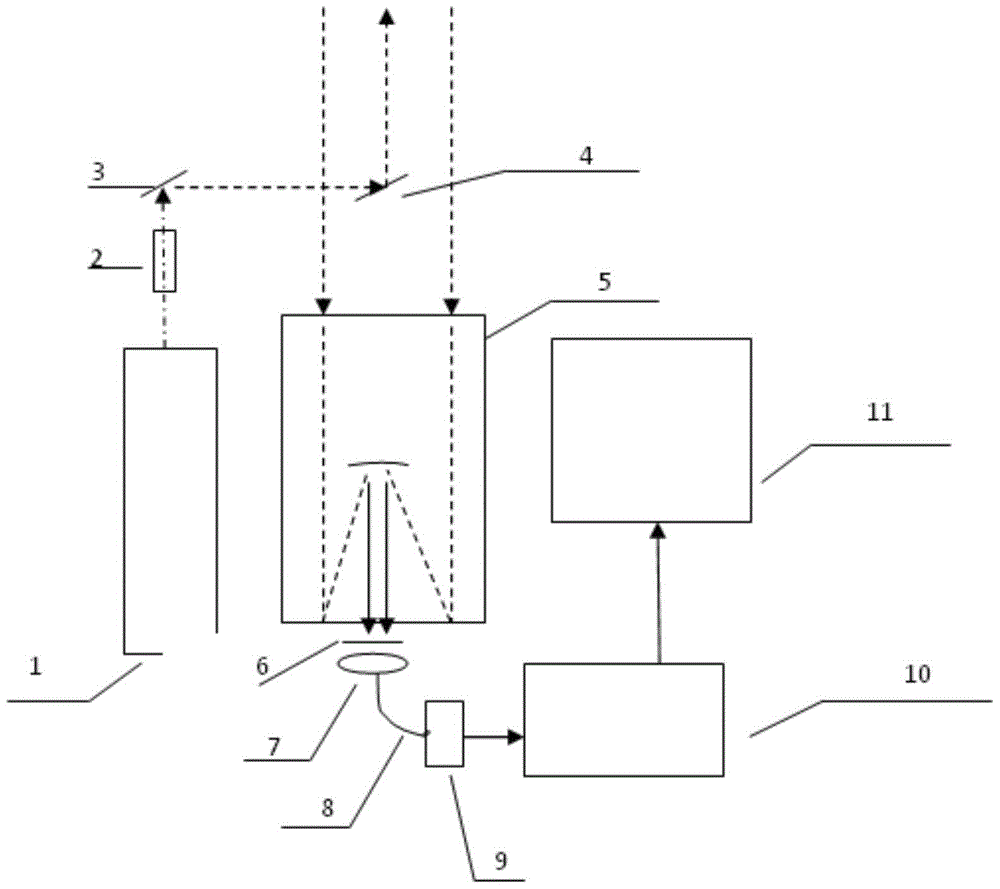A coaxial aerosol lidar system with eye-safe wavelengths
An eye-safe, lidar technology, used in radio wave measurement systems, re-radiation of electromagnetic waves, instruments, etc., can solve problems such as unsafe crowds, harmful eye safety, and short detection distances, and improve spatial resolution accuracy. , The effect of reducing the light trigger delay and minimizing the blind area
- Summary
- Abstract
- Description
- Claims
- Application Information
AI Technical Summary
Problems solved by technology
Method used
Image
Examples
Embodiment 1
[0049] Such as figure 1 shown.
[0050] A coaxial aerosol lidar system with eye-safe wavelengths, including a laser unit, a reflected laser acquisition unit, and a data acquisition unit;
[0051]The laser part includes a laser and a beam expander 2, and the laser light emitted by the laser 1 is translated by the beam expander 2 and a pair of mirrors 3 arranged in parallel, so that the outgoing direction of the translated laser is consistent with the reflection The laser collection unit is set coaxially; the parameters of the laser are 1) wavelength range: 1.4-1.8 μm; 2) single pulse energy: >10uJ; 3) pulse repetition frequency: 1-50kHz; the laser is an OPO laser, The reflected laser collection unit includes a telescope 5, a narrow-band interference filter 6 and a lens arranged in sequence along the reflected laser reflection direction; the lens is an aspheric lens 7;
[0052] Described data collection unit comprises InGaAs APD single-photon counting system 9, and described a...
Embodiment 2
[0069] A kind of coaxial aerosol lidar system of human eye safety wavelength as described in embodiment 1, its difference is that,
[0070] The data acquisition unit also includes a data acquisition card 10 and a computer 11; the data acquisition card 10 collects the laser data collected in the InGaAs APD single photon counting system 9 and transmits it to the computer 11;
[0071] The trigger signal of the InGaAs APD single photon counting system 9 and the data acquisition unit is directly derived from the trigger signal of the OPO laser;
[0072] The data acquisition card adopts MSP-800 series single-photon counting card, and the parameters of the counting card are as follows, channel mode: dual channel; measurement speed: 800MHz; gate pulse width: 1ns; slot type: PC slot.
Embodiment 3
[0074] A coaxial aerosol lidar system with a human eye-safe wavelength as described in Examples 1 and 2, the difference is that the InGaAs APD single-photon counting system uses a 1.25GHz sinusoidal gating to realize the InGaAs APD detector In Geiger mode.
PUM
 Login to View More
Login to View More Abstract
Description
Claims
Application Information
 Login to View More
Login to View More - Generate Ideas
- Intellectual Property
- Life Sciences
- Materials
- Tech Scout
- Unparalleled Data Quality
- Higher Quality Content
- 60% Fewer Hallucinations
Browse by: Latest US Patents, China's latest patents, Technical Efficacy Thesaurus, Application Domain, Technology Topic, Popular Technical Reports.
© 2025 PatSnap. All rights reserved.Legal|Privacy policy|Modern Slavery Act Transparency Statement|Sitemap|About US| Contact US: help@patsnap.com

